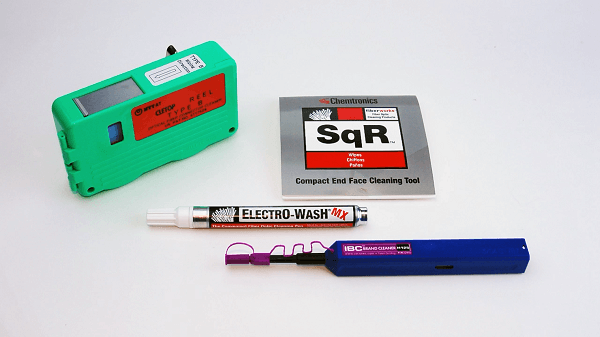Table of Contents
Unclean fibers are one of the main reasons fiber networks fail or have issues, so fibers must be cleaned before installation and regularly after that. Every fiber connection should get double-checked, so it’s clean before getting plugged in.
But, you may be wondering how to clean fiber optic cables. Unfortunately, it’s not a simple matter of just blowing them off or wiping them. They must be adequately cleaned if they’re expected to work well.
Below we explain the best methods to clean fiber optic cables and break down the various materials you need to get the job done.
Dirty Fiber Optic Connectors
Dirty fiber optic connectors can be the downfall of any network, so it’s critical to ensure they’re clean before installation occurs. Even a single spec of dirt can be the difference between a well-functioning fiber optic connector and a poor one.
Additionally, if all your fiber optic connectors are properly cleaned for installation, it will make troubleshooting other issues easier.
Tools You Will Need
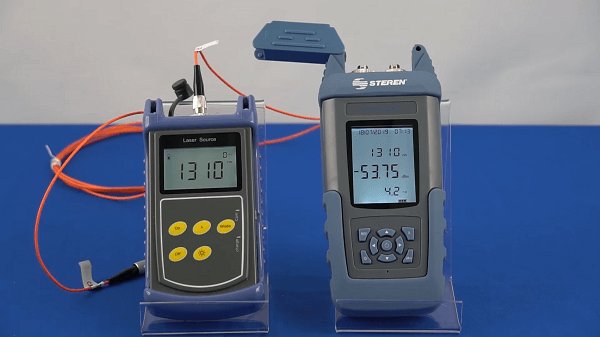
There are a few tools that may come in handy when cleaning a fiber optic cable. Here’s a brief list of the necessary materials.
Fiber Cleaning Pen or Click-clean Pen
Fiber optic cleaning pens are useful for wiping off:
- Connector heads
- Bridge ports
- SFP cards
These pens are affordable and easy to use.
Non-woven and Lint-free Wipes
If there is heavy residue on the pen, these wipes will be necessary to thoroughly clean the connector.
Fiber Optic Cleaning Solvent
This solvent is necessary when there’s heavy residue on the connector, such as some kind of oil. Between this and the wipes, cleaning connectors will be simple.
CLETOP-S
This CLETOP-S tool is similar to the click-clean pen, making cleaning fiber optic connectors simple. The cleaning tape can get swapped out, making this device cost-effective in the long run.
Fiber Optic Cable Tester
This tool allows you to check and see if the connector is clean. With the above different items, you should be sufficiently equipped to clean any fiber optic connector, whether it’s a little dirty or covered in residue.
Alternatively, you can purchase a complete fiber optic cleaning kit. This nifty kit comes with all the necessary materials, including:
- Cleaning pens
- Wipes
- Cleaning swaps
How Not To Clean a Fiber Optic Cable
There are several that users and technicians should avoid when cleaning fiber optic cables. A damaged fiber optic connector is worse than a dirty one.
Don’t Blow on the Fiber Optic Cable
First, don’t blow on the fiber cable with your mouth or a compressor. This cleaning method will only move particles around and not clean the inside.
If you blow with your mouth, it could also add moisture to the cable. If you blow on it with canned or compressed air, you may be coating your cable with liquid propellants.
Don’t Be Forceful With Your Fiber Optic Cables
It can be easy to get careless when cleaning fiber optic cables, but you should handle them with care. Failing to do so can leave them damaged and more prone to problems, if not useless.
Don’t Look Into the Laser
This tip has little to do with the cleaning process but is important nonetheless. Ensure the laser is off before cleaning to be safe and never look into it. Looking into the laser can cause irreversible eye damage.
Methods Of Cleaning
How To Use the Dry Cleaning Method
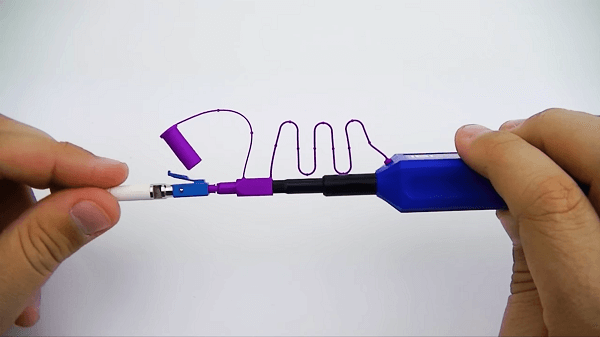
If you use the dry cleaning method, there are only two steps you will have to follow to be successful. Below is how to clean fiber optic cables using the dry cleaning method.
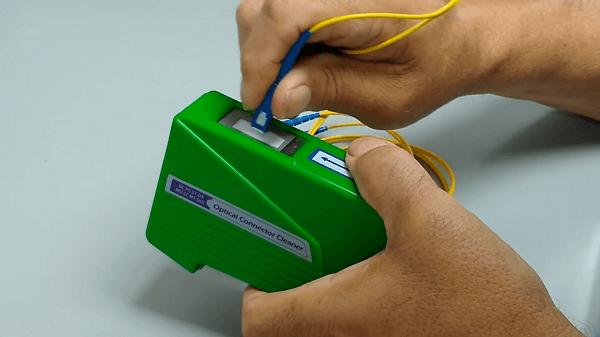
- To begin, remove the dust cap and insert the click-clean pen or apply the CLETOP-S to the head of the cable. If you’re using the click-clean pen, push until you hear a click, and if you’re using the CLETOP-S, pull the trigger to clean the head.
- After this, check the head with the fiber optic tester. If it is clean, connect it. If it is not, you will need to use the wet-dry cleaning method to clean it off, as there is likely some residue or stubborn dirt on the connector.
How To Use the Wet-dry Cleaning Method
This method is the best way to clean a fiber optic cable. The wet-dry cleaning method is slightly more complicated than the dry cleaning method, but it’s still relatively simple.
Below are a few steps to follow for successful cleaning.
1. Get the fabric ready
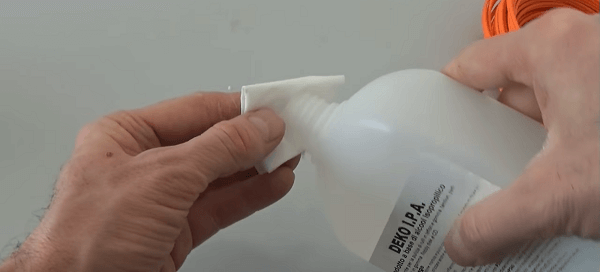
First, take the non-woven and lint-free pad and add a dime-size drop of isopropyl alcohol to it, preferably close to one of the edges. Make sure you don’t add too much, or the fiber optic cable will not be adequately cleaned and dried.
2. Wipe it
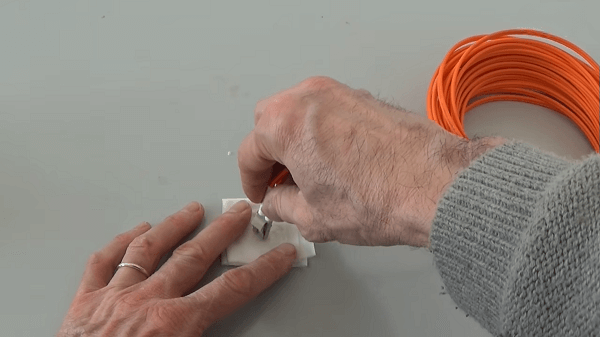
After the above step, place the wipe on a flat surface, like a table, and remove the dust cap from the fiber optic connector. Now gently rub the end of the fiber optic cable across the wipe or pad, going from the spot where you added the solvent straight to a dry part of the line. Repeat this two or three times.
3. Test it
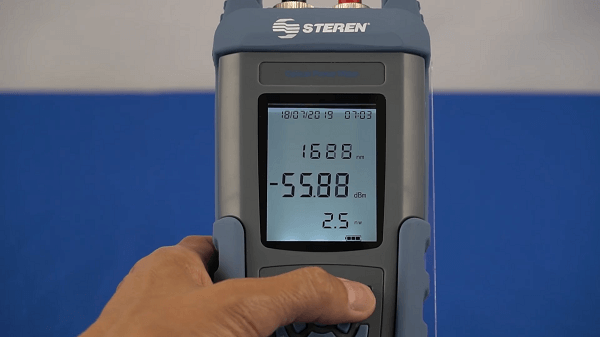
Once you’ve cleaned the fiber optic cable, check it with a fiber optic tester to ensure there’s no leftover residue. If it is clean, reinsert the fiber optic cable. If it’s not clean, wipe it a few more times and check again.
How To Tell If Your Fiber Optic Cable Is Faulty
If you clean your fiber optic cable and it’s still not functioning, it may not be your fault. Fiber optic cables can have all sorts of problems. Odds are the cable has gone bad and you need to replace it. There are a few things to check if your fiber optic cables aren’t functioning optimally.
Wrong Fiber Connection
If your fiber optic cable isn’t transmitting, it may be because the fiber connection may be the wrong type. The way to test this is with a fiber tracer.
A fiber tracer tests if a light is passing through your connections. This process will show you if there’s a problem with your connections and show where the problem is occurring.
Kinks or Fraying
If your fiber optic cable isn’t transmitting light, it may be because it cannot pass through a kink or the cable has lost integrity due to fraying. Check along the cable for any visible problems with the line.
Scratched Connectors
Another common problem is a scratched connector. If there are any scratches or damage to the fiber optic cable connector, then it won’t transmit light, causing it to be distorted. This issue can be checked with a high-quality fiber-optic tester.
Frequently Asked Questions
Now that you know how to clean fiber optic cables, you may still have a few questions. Below are some frequently asked questions about these types of cables.
How do you take care of a fiber optic cable?
The best way to take care of fiber optic cables is to keep them clean and organized. Ensure you regularly check the connections between cables and clean them if need be. Additionally, you want your fiber optic cables out of the way and well organized to avoid damage and kinks that could disrupt the line.
What can damage fiber optic cables?
Many things can damage fiber optic cables. They can get damaged in transport from rough handling, they can get scratched if improperly cleaned, they can get water damage, and rodents can chew through wires. Additionally, cables can freeze in extreme weather conditions.
Users should be careful when handling fiber optic cables, so they don’t damage them. It also helps to keep them in a place that doesn’t have moisture and is protected from rodents or pets.
Can water damage a fiber optic cable?
Water can damage a fiber optic cable, but this depends on whether the cable is indoor- or outdoor-rated.
If it’s an indoor-rated cable, water will damage it and make it unusable. If it’s outdoor-rated, the cable will withstand water damage as long as it maintains its integrity. Remember that cables will wear out over time when left exposed to the elements. Always replace cables that have visible faults.
How long do fiber optic cables last?
In general, fiber optic cables should last around ten years, but they can often last much longer. Much of this depends on installation and location.
If the cables are in an ideal location and installed perfectly, they could last several decades. Rarely, however, can the ideal scenario be met, so it varies with each cable.
Are there any disadvantages of fiber optic cables?
There are several disadvantages of fiber optic cables. While fiber optic cables are fantastic for ensuring high-speed networks and long-distance coverage, these cables are more fragile.
These cables tend to break if handled incorrectly. They’re also more expensive and need to be installed by a specialist.
Cleaning Fiber Optic Connectors
Above is a breakdown of how to clean fiber optic cables. Fiber optic cables are a great networking solution but one that requires some care and attention, especially for the installation process. Several things can go wrong, so it’s best to have the odds in your favor by ensuring your connections are clean and undamaged.
Having clean connections is critical for optimal installation but also general maintenance. You’ll avoid many networking issues simply by ensuring your fiber optic connections are free of dirt and residue. Whether you’re installing or maintaining, having clean cables is vital to network health.

